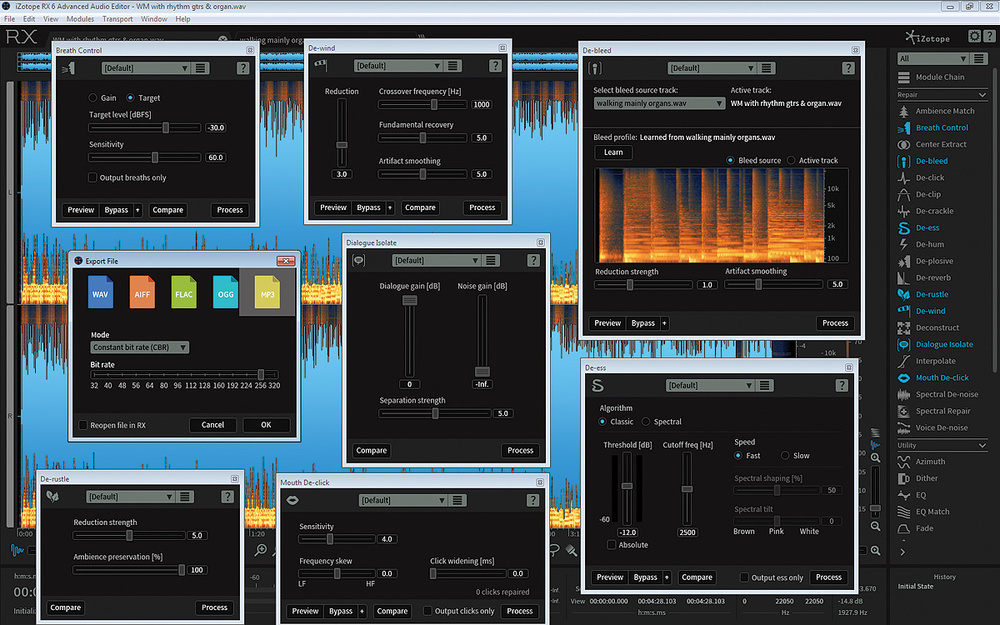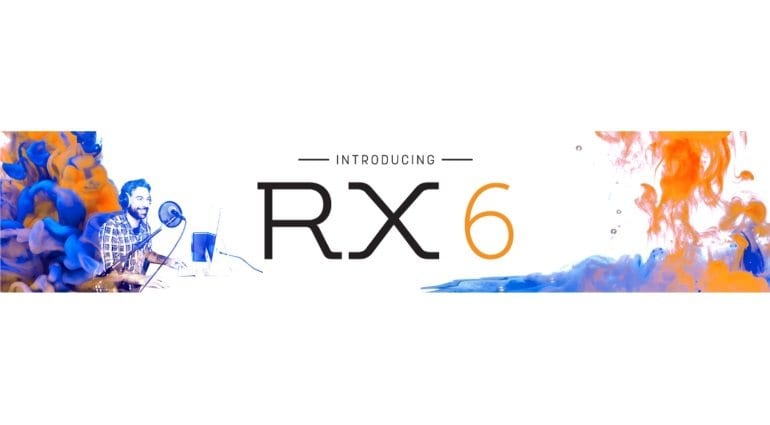Izotope Rx 6 Time And Pitch
In its time, iZotope RX3 Advanced offered the most comprehensive suite of noise-reduction software—available as a stand-alone application and as bundled plug-ins—for post-production sound, along with extensive metering, time- and pitch-shifting processors, resampling facilities and other invaluable tools. RX 4 Advanced ($1,199) adds several workflow accelerators used to comply with various loudness standards and to quickly adjust level, timbre and ambience in tracks.
Tricky Audio Problem? Solve it with iZotope Plug-ins Dec 23, 2019. Learn how to use iZotope plug-ins to save time, improve your skills, and solve problems you thought were impossible with tutorials, tips, and insights, into your favorite iZotope products. Time-Stretch & Pitch-Shift. IZotope Radius is iZotope's offline time-stretching and pitch-shifting algorithm, designed for completely transparent operation on a wide variety of source material. Radius brings world class time-stretching and pitch-shifting to the selection based RX restoration platform, creating a powerful array of tools and al. It’s no secret that iZotope RX is the king of audio repair. IZotope’s cutting-edge spectral processing software is by far the best solution for fixing frequent audio issues such as low-end rumble, intermittent background noises, sibilance, mouth clicks, and more.
I reviewed Version 4.0.1 of RX 4 Advanced (its plug-ins in AU format) using Digital Performer V. 8.06 and an 8-core Mac Pro running OS X 10.9.5. For a refresher on RX 4 Advanced’s legacy features, check out my review of RX3 Advanced in the May 2014, issue of Mix.
- RX 6 Overview. IZotope’s award-winning RX 6 Audio Editor is the industry standard for audio repair, restoration, and enhancement. It offers a comprehensive suite of tools focused on alleviating common to complex audio issues.
- IZotope Radius. IZotope Radius™ is a world-class time-stretching and pitch-shifting algorithm. You can easily change the pitch of a single instrument, voice, or entire ensemble while preserving the timing and acoustic space of the original recording. IZotope Radius is designed to preserve the natural timbral qualities of the original file, even when applying extreme pitch shifts.
Streamlined Interoperability
RX’s Spectral Repair plug-in—which was a bit of a kludge in previous releases—has been discontinued, made obsolete by the new RX Connect plug-in and alternative DAW interoperability. Roughly half of leading DAWs use RX Connect as a synchronized bridge to the stand-alone RX 4 Advanced application; you first select in your DAW the audio clip you wish to process, then launch RX Connect. Other DAWs (including DP) use RX 4 as an external editor: In DP, for example, you choose the RX application as DP’s external waveform editor and then open a region in RX via DP’s Audio menu.
No matter which protocol your DAW uses, after the RX application opens you can edit the selected clip using any processing (not just Spectral Repair) it provides. Different (fast and simple) methods are used, depending on your workstation, to return the processed clip back to your DAW in perfect sync with the original clip. Because some DAWs (including Pro Tools) monopolize the system’s audio drivers, an additional plug-in dubbed RX Monitor is included to enable hearing the RX application’s output; RX Monitor interacts with your DAW like an instrument to play the RX application’s audio through the DAW’s driver.
The updated Remove Hum plug-in and module—all modules belong to the standalone application—include an Adaptive mode that analyzes your audio and automatically notches out fundamental hum-related frequencies that change over time (such as in audio for a scene that was shot in multiple locations).

The updated Time & Pitch module provides an option to run Radius processing in real time, for those tasks in which you need fast processing. The tradeoff is lower quality than with offline processing (which is still available).
New Modules
The new Leveler module uses a compressor with automatic makeup gain to curb fluctuations in signal level. Use its Target RMS slider to adjust the K-weighted RMS level of your clip. The Speed slider alters how quickly gain is adjusted. Drag the Amount slider to limit the maximum amount of gain (boost or cut) that can be applied, and raise the Noise slider to reduce potential pumping when breathing or other broadband noise occurs during gaps in dialog. You can view the gain changes that Leveler applies and edit them by dragging up and down one or more nodes at once on a graphical curve (dubbed the Clip Gain envelope; see Figure 1).
The new Loudness module automatically applies a fixed amount of gain to your entire clip (or a selected region) to instantly make it comply with a specific standard, such as BS.1770, selected from a drop-down menu. Alternatively, you can use two sliders to manually set the desired loudness (in LKFS units) and maximum true peak level of the clip. A post-limiter is automatically applied as needed to meet the selected true-peak spec.
The new EQ Match module applies static equalization to purportedly make one region’s spectral balance conform to that of another. Simply select a region (such as a phrase in a VO track) that sounds great, click Learn, select another region that sounds bad, and click Process. EQ Match lets you save spectral profiles as presets, speeding your workflow.
The Ambience Match module does for noise what EQ Match does for timbre, with one caveat: It can’t decrease the amount of ambience that already exists in a selection; it can only increase it. This is an invaluable tool for matching an ADR track’s ambience to that of the recording being replaced. You simply make a selection of the noise in the live recording, click the module’s Learn button, make a selection in your ADR track where you want the same-quality noise added, drag the Trim control to adjust the level of the ambience to be added, and click Process. Noise snapshots can be saved as custom presets.
In Post-Production Sessions
I used RX 4 Advanced extensively while working on five video projects containing many dialog tracks, music and B roll. The new Leveler module gave me excellent results easily and exceedingly fast, smoothing levels no matter the track’s spectral balance. It controlled boomy-sounding peaks beautifully, often precluding the need to de-boom using multiband compression. With moderate settings—the Amount control set no higher than 4 dB—I got more natural-sounding results than when using my go-to compressors and limiters. After rendering the processing, I could mouse-drag one or more nodes at once in the automatically generated clip-gain envelope to alter Leveler’s gain changes in select spots (see Fig. 1).
The Loudness module conformed my mix to any of seven different loudness standards with just a couple of mouse clicks—a real timesaver. Using the Ambience Match module, I could capture the room tone on a dialog track and add it to another track that sounded too dead; a trim control let me adjust the level of the ambience ±6 dB without affecting the level of the dialog. Listening to the generated ambience in isolation, it was apparent it was synthesized. But in the mix, it worked inconspicuously if applied sparingly to tracks in select, short gaps.
I tried a couple dozen times to use EQ Match to smooth spectral balances on dialog tracks, but I always found I got better (and more predictable) results using a combination of static and dynamic equalization plug-ins.
Any editing performed on tracks in the RX application is destructive once sent back to DP (overwriting the original file everywhere it occurs in DP), a disadvantage compared to working with RX 4 Advanced’s nondestructive plug-ins. Overwritten files initially played back as—and looked like, in DP’s Sequence Editor—full-scale, broadband noise in DP; rebooting DP would always permanently restore pristine playback, but I’d sometimes also need to bounce the file to a new track to restore proper waveform display. This appears to be a bug in DP, not in the RX application.
On startup, the RX application would often arbitrarily reroute consistent output assignments to different MOTU I/O boxes or banks—sometimes to those disabled in the MOTU PCI Audio Setup utility. And I often heard distracting crackling noises and clicks while working with the application, especially while previewing a module’s processing. (An associate of mine confirmed hearing the same artifacts using RX 4 with a different system.) Thankfully, the artifacts did not print when files were overwritten back to DP; nor did they ever occur when using the RX plug-ins.
Purchase in Advance?
Wine mono installer mac. If you want a version of Wine that is packaged specifically for macOS, then use! Instead of simulating internal Windows logic like a or emulator, Wine for macOS translates Windows API calls into POSIX calls on-the-fly, eliminating the performance and memory penalties of other methods and allowing you to cleanly integrate Windows applications into your desktop.Note: this listing is for the official release of Wine, which only provides source code. Wine for Mac (originally an acronym for ' Wine Is Not an Emulator') is a compatibility layer capable of running Windows applications on several POSIX-compliant operating systems, such as Linux, macOS, & BSD.

Izotope Rx 8
iZotope also offers a less-expensive “standard” version, which doesn’t include the Dereverb, Deconstruct, Leveler, Loudness, EQ Match, Ambience Match, Radius RT (Time & Pitch) and Insight (metering suite) modules and plug-ins. It also lacks the center-channel extraction and azimuth alignment features for the Channel Operations module and some extra controls for Denoiser, Spectral Repair and Declick. Many of these additional features included with the Advanced version have proven to be indispensible in my work; they are well worth the extra cost.
If you work in post-production sound, restoration or audio forensics and don’t already own RX3 Advanced, buying RX 4 Advanced is an absolute must—if only for its incredible legacy plug-ins. If you can tolerate the RX application’s intermittent routing and monitoring problems, the Leveler and Loudness modules make an upgrade from RX3 Advanced worthwhile.
Mix contributing editor Michael Cooper is a recording, mix, mastering and post-production engineer.
TRY THIS
Izotope Rx 6 Audio Editor
DP can send only one region at a time to an external editor such as RX 4 Advanced. If you want to send an entire track containing non-contiguous soundbites, first make a time-range selection in DP for the entire track and select Merge Soundbites (option-shift-M).